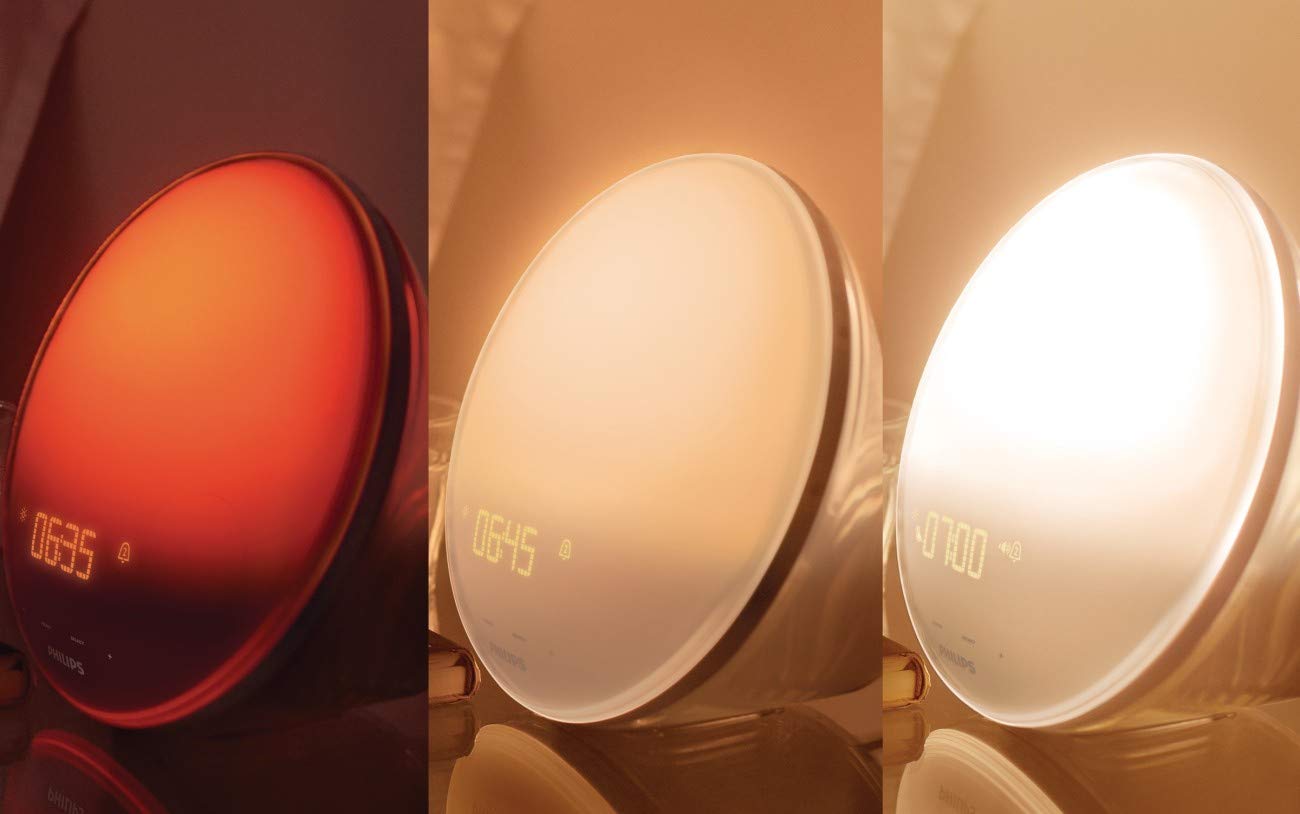Last Updated on March 30, 2023
Our internal alarm clock is naturally programmed by nature to wake up when the sun starts to shine. Unlike modern alarm cocks, our biological alarm clock is designed to wake us up gradually, using natural sunlight.
Not an alarm sound.
The average modern-day alarm – on a clock or on your phone – jolts you awake. But, your brain is still in “sleep mode”.
Your biological alarm clock is designed to wake you up gradually, as the brightness of the sunlight intensifies. This allows you to slowly wind up, and transition from sleep mode to wake mode.
The dreaded morning feeling where you just don’t want to get out of bed is the result of being in sleep mode. Your alarm device screams at you to wake up.
You’re up, and yet still half asleep.
The most simple solution to this is to ditch your alarm, and sleep outside – which obviously isn’t practical. The next best thing is to simulate a natural environment setting using a natural light alarm clock.
Something that uses colored sunrise simulation to wake you up gradually. Something like the Philips HF3520 Wake-Up Light Alarm Clock.

With the Philips Wake-Up Light Alarm Clock, you wake up gradually, over the course of 30 minutes.
It allows your brain and body to fully transition from sleep mode to wake mode. This means you get to wake up fully refreshed, with no brain fog.
How the Phillips Wake-Up light works
Have you ever seen the lamps used for light therapy to treat seasonal affective disorders? This type of light therapy tricks your brain into thinking that the sun is shining outside.
The Philips Wake-Up light is very similar, except not as bright.
Here’s how it functions:
20-40 minutes before your scheduled alarm time, the Philips Wake-Up light sets its light curve into motion. (You get to choose the time it takes to wake you up – between 20-40 minutes.)
The light gradually increases from red to orange, and then a dim yellow light. It intensifies all the way up to a bright white light that is powerful enough to illuminate your entire bedroom.
The light mimics natural sunlight, as it uses colors of a similar spectrum.

Your brain senses the naturally-appearing light, and begins to wind down the “sleep mode” and activate “wake mode”. The light itself has 20 brightness settings, so you can adjust it to your preference or sensitivity as needed.
You can also set some sound alarms to compliment the morning light, like the sound of birds chirping.
The significance of the light curve
The key to this style of alarm is the light curve that it uses.
With a traditional alarm, you set the desired time – let’s say 7:00 AM. The alarm sounds off at 7:00 AM with no regard as to where you are in your sleep cycle.

If you happen to be in deep sleep mode when the alarm hits, you’ll wake up super cranky. You’ll suffer from serious brain fog, and it will be a struggle to get out of bed.
The Wake-Up alarm clock from Philips initiates the “wake-up sequence” at 6:30 (if you choose 30 minutes).
As the light starts to intensify, it signals your brain to exit the deep sleep mode. It gradually transitions through light sleep, and into wake mode.
Night mode
The same principle applies for nighttime, only in the reverse. Our nighttime clock is designed to have us gradually wind into sleep mode, not abruptly by turning the lights off.
The sun doesn’t set using a light switch. It gradually goes down, and the intensity of the sunlight gradually decreases.
The Philips Wake-Up light functions as a night clock as well.
You set a “sleep alarm”, and the intensity of the light dims gradually over your desired time setting, and winds you down slowly and comfortably into sleep.

You set your desired “sleep time” – let’s say 9:30 PM.
Then, At 9:00 PM, the light starts to dim incrementally, preparing your body to fall asleep – gradually. You wind up gradually in the morning, so it only makes sense that you gradually wind down at night.
Just turn off all of your lights, and turn the clock to night mode.
You might experience a learning process when adjusting to the limited amount of time you have before you go to sleep. But over time it will train you to develop a consistent sleep-time routine.
A consistent sleep routine is probably the most effective way of preventing sleep anxiety, insomnia, and other sleep issues.
The different settings available
Sound settings
You have your choice of Bird Song, Birds in the forest, Zen Garden, Gentle piano, and Seaside Sounds. You can also set it to your favorite FM radio station. (Both can be volume-controlled).

You can also hit the snooze button (the button is the actual alarm clock itself), and the sound will turn off for 9 minutes.
These are sound “settings”. You can choose to turn them on, or you can wake up with no sounds at all.
Brightness settings
Everyone has different sensitivities to light. The amount of light that I need to wake up might be too dim for you, and too bright for others.
For that matter, as the light intensifies, it takes less time to become fully awake. And some people would prefer a longer or shorter wake-up period.
The Philips Wake-Up light allows you to personalize your alarm clock with 20 brightness settings.

Display settings
The display has 5 brightness levels and can be adjusted between high, medium, low, very low, and none.
The display also automatically dims when the lights are off. When the lights are on, the display brightness is set to your preferred setting.
When the lights turn off (or when your night clock gradually dims to no light), the display dims so that it does not disrupt you while you sleep.

Alarm settings
You can set two alarms simultaneously.
This is convenient since most people wake up at the same time Monday through Friday. And usually a bit later Saturday and Sunday.
You can set an alarm for the weekdays, and another one that goes off a bit later during the weekend.
Can this be used as a light therapy lamp?
It can, but with minimal effects.
A typical light therapy lamp is rated at around 10,000 lux. The Philips Wake-Up light is 300 lux.
Final thoughts
Some of us want to wake up more naturally, while others just hate to get up in the morning. And many of us, of course, struggle with setting a consistent nighttime routine.
The Philips Wake-Up Light alarm clock solves all three of those issues.
